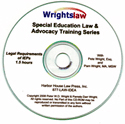|
|
How can you know where you want your child to go, what your child needs to learn, if you don't know where s/he is now?
"If you're not sure where you're going, you're liable to end up someplace else. If you don't know where you're going, the best made maps won't help you get there." - Robert Mager, psychologist, writer, educator
If you begin the IEP process by trying to find generic "good goals," you will probably fail because the goals won’t relate to your child's unique needs.
Your child's IEP must include:
- a statement of your child's present levels of academic achievement and functional performance;
- a statement of measurable annual goals, including academic and functional goals, designed to meet all of the child's needs that result from the disability;
- a description of how your child's progress toward meeting the annual goals will be measured, and when parents will receive periodic progress reports;
- a description of the special education and related services and supplementary aids and services the school will provide the child;
- a statement of appropriate accommodations to measure the child's academic and functional performance on state and district tests; and
- a statement of the date for beginning services, frequency, location, and duration of services and modifications.
Don't put the cart before the horse! In this issue of the Special Ed Advocate, you'll find an IEP Game Plan that will describe how to create a SMART IEP, step-by-step.
Don't hesitate to forward this issue to other families, friends, and colleagues.

Sign up free today! l Read previous issues |
|
| Where is Your Child Functioning Now? |
Present Levels of Academic Achievement and Functional Performance
IDEA 2004 requires the IEP team to describe the child's "present levels of academic achievement and functional performance." The present levels of performance should describe the child’s unique needs that result from the disability.
If you begin this process by analyzing your child’s present levels of academic achievement and functional performance first, the IEP process makes sense.
Pete says the IEP that Florence County Public Schools prepared for Shannon Carter is one of the better written IEPs he has seen. Why? Florence County's IEP included two clear, measurable goals:
- Shannon will progress from the 5.4 to the 5.8 grade level in reading as measured by the Woodcock Johnson Reading Mastery Test
- Shannon will progress from the 6.4 to the 6.8 grade level in math as measured by the KeyMath Test
Why did the U. S. Supreme Court find that this IEP was not appropriate? The goals were set too low. Shannon was about to enter 10th grade. If she met these goals, she would have fallen even further behind her classmates. |
back to the top |
|
| Where Do You Want Your Child to Go? SMART IEP Goals |
You can help the child get and stay on the right path by designing SMART IEP goals.
The term SMART IEPs describes IEPs that are:
S Specific
M Measurable
A Use Action Words
R Realistic and relevant
T Time-limited
Specific
SMART IEPs have specific goals that target areas of academic achievement and functional performance. These goals include clear descriptions of the knowledge and skills that will be taught and how the child’s progress will be measured.
Measurable
SMART IEPs have measurable goals. Measurable means you can count or observe it.
When goals are measurable, parents and teachers know how much progress the child has made since the performance was last measured. With measurable goals, you will know when the child reaches the goal.
Action Words
IEP goals include three components that must be stated in measurable terms:
(a) direction of behavior (increase, decrease, maintain, etc.)
(b) area of need (i.e., reading, writing, social skills, transition, communication, etc.)
(c) level of attainment (i.e., to age level, without assistance, etc.)
SMART IEPs use action words like: “The child will be able to ...”
Realistic and Relevant
SMART IEPs have realistic, relevant goals and objectives that address the child’s unique needs that result from the disability.
SMART IEP goals are not based on district curricula, state or district tests, or other external standards.
Time-limited
SMART IEP goals are time-limited. What does the child need to know and be able to do after a specified period of time? What is the starting point (i.e., present levels of academic achievement and functional performance) and what is the end point?
Time-limited goals and objectives enable you to monitor progress at regular intervals. |
back to the top |
|
How to Get There: Your Game Plan |
You know your child's present levels of academic achievement and functional performance. You know your child's unique needs and what you want the child to learn and achieve during the next academic year. What's next?
Your Game Plan includes three elements. You need to learn about test scores, SMART IEPs, and how to use advocacy strategies to get the services your child needs.
Download and read these articles and resources.
1. Your Child's Test Scores. Read Chapters 10 and 11 (Tests and Measurements 101 and 102) in Wrightslaw: From Emotions to Advocacy, 2nd edition or download the article, Tests & Measurements for the Parent, Educator, Advocate and Attorney.
Tip: If you download this article, make sure you get the graphics. It may be better to print the article from the screen to ensure that you have the graphics.
2. SMART IEPs. Read Chapter 12 about SMART IEPs in Wrightslaw: From Emotions to Advocacy, 2nd edition by Pam & Pete Wright. You may also download a free copy of the chapter about SMART IEPs from Wrightslaw for your personal use.
3. Advocacy Strategies. Download and read SMART IEP Goals: A Tactics & Strategy Session with Pete & Pam Wright.
Expect to read the articles more than once. Plan to read the information about Tests and Measurements at least three times. Use a highlighter. Make margin notes. Be patient.
You'll find the full text of this article at Wrightslaw Game Plan: Smart IEPs.
https://www.wrightslaw.com/info/iep.goals.plan.htm |
back to the top |
|
How to Make it Happen: Use Tactics and Strategies |
What's your target? How can you get SMART goals in your child's IEP?
What can you do if the school wants to measure progress by "teacher observations" or "teacher made tests," not objective tests of academic achievement and functional performance?
In SMART IEPs: A Tactics and Strategy Session, an interview with Pete and Pam Wright, you will learn about:
- requirements for present levels of academic achievement & functional performance
- how to use a private educational consultant
- requirements for measurable academic and functional goals
- accommodations and modifications
- impact of low expectations
- how to avoid methodology disputes
- tutoring & how to find qualified tutors
- response to intervention (RTI)
- extended school year (ESY)
- the parent's (active) role
Read SMART IEPs: A Tactics and Strategy Session, the interview with Pete and Pam Wright. You'll be glad you did! |
|
back to the top |
|
| The Wrightslaw Way |
 The Wrightslaw Way to Special Education Law and Advocacy is new and different. The Wrightslaw Way to Special Education Law and Advocacy is new and different.
When we post an article or a request for information or help, visitors leave helpful comments, answers and questions.
Learn how a special ed teacher was able to advocate successfully for a student, visit a discussion about whether ADHD is a learning disability, how to get accommodations on testing, and much more.
Take a look at the new The Wrightslaw Way blog for an exciting new experience. If you were not one of the 9,000 people who visited the blog last week, check it out!
|
|
back to the top
|
|
|










